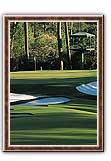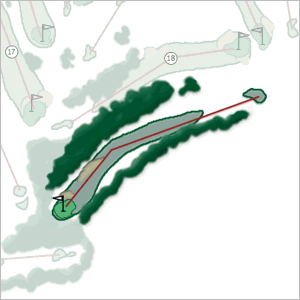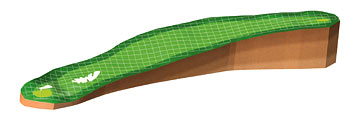| Hole Names | |
|
|
|

Hole #10CamelliaCamellia sasanqua Par 4, 485 Yards |

|
||
|
A long par 4, this hole plays downhill. Players will try to drive the ball to left or center of the fairway hitting a second shot into a green that slopes right to left. Prior to 1935 this was the first hole at Augusta National and today it serves as the first hole of a playoff. Hill on the right and severe downhill slope compensates for extreme length. A well-placed, drawn tee shot can set up short-iron approach to shaded green that often is among the fastest on the course. Hill on the right and severe downhill slope compensates for extreme length. A well-placed, drawn tee shot can set up short iron into a shaded green that can be the fastest on the course. A downhill dogleg left, the second shot being to an elevated green on which it is difficult to judge just where the pin is located. | |||

QuickTime AVI (5.29M) Animated GIF | |||
|
Jack Nicklaus says: Driver or a 3-wood, depending on the wind conditions. If you hit driver, you're going to have to hit it the left side or you'll hit it through the fairway on the right. You have the best angle from the left side. The green is relatively difficult, but not extremely so. At 485 yards, the 10th hole at Augusta National is one of the longest par 4s in major championship play. Itís either driver or 3-wood off the tee, but you need to hit the ball down the left-hand side because it gives you both added distance and a better angle to the green. The one thing you need to avoid is driving it through the fairway on the right because the green best receives a ball played with a fade. A draw will often run through the green or drop off to the left. From there, itís extremely difficult to make par. Iíll play for the center of the green but favor the front or the back, depending on where the flag is positioned. My birdie here on Sunday in 1986 really got me going. However, in hindsight, I should have hit 3-wood rather than driver because the ball went too far right and I was fortunate the gallery blocked the ball from going into the trees. I hit a sweet 4-iron to about 25 feet and made the putt for birdie. Ideally, you want to be at even par or maybe one or two under as you head to the second nine because anything can happen. Ben Crenshaw made a curling 60-foot birdie putt here in 1984 that spurred him on to his first Masters victory. Fuzzy Zoeller says: You have to play your drive down the left side with a little hook. If you go down the right side, it makes the hole 25 yards longer. Second shot is straight downhill, but the green is a big target that slopes back to front. The key to his hole is the tee shot. Tiger Woods says: It's actually the same length as No. 13, a par-5, but there's a speed slot down the left side. You'll see a lot of guys hit 3-wood or a low driver, something they can turn from right-to-left. Anything left up on the top right, you'll see anywhere between a long iron or fairway wood, and the green doesn't receive shots very well. You have to hit a cut into that green, it slopes severely from right to left. Try to keep the ball below the hole at all costs. Fred Couples says: The last couple of years I started to hit 3-wood off the tee because I can hook it. Once you get it to the left, it goes down the hill into a little speed slot, then you have a 7- or an 8-iron left. And if you leave it to the right, you don't get any roll and you have a 4- or 5-iron. It's hard to believe you can have a three- or four-club difference but when you get the roll or don't get it. With a difficult second shot to a green that slopes from the back to the front, you want to hit your iron shot short of the pin and have an uphill putt. In the final round here in 1992, I hit it in the bunker, but did get it up and down. Bernhard Langer says: The first time I looked at the leader board back in 1985's final round, I was on the 10th tee. You have to be within five shots or so at this point on Sunday to have any hope and I was hanging in there, four behind Curtis Strange. I knew I had to be aggressive and make as many birdies as possible. Off this tee you want to draw the ball because you get more of a run if you hit it down the left side. From the right half of the fairway, you have to hit a much longer shot off of a downhill lie. From the left side, though, players generally are hitting anything from a 5-iron to a 9-iron to the green, which slopes back to front and right to left. As on the ninth, you don't want to be short here or the ball will roll back into the fairway. You also don't want to be left or long because the ball can easily kick 20 yards into the trees. Ideally, you should place the ball short and left of the hole. I was in a German television booth back in 1989 when Scott Hoch missed his short downhill putt in the playoff. Before the putt, the announcers thought Hoch was going to win, but I knew how tough it was going to be.
| |||

Hole #10CamelliaCamellia sasanqua Camellia japonica is a classic flowering evergreen shrub belonging to the Tea Family, and is native to China and Japan. The Berckmans imported plants from Japan, France, England, Germany and Belgium, and listed 42 named varieties in P.J.A. Berckmanís catalogue of 1890. Blooming period and color vary depending on variety (November through March). Both the japonica and sasanqua species are in abundance on this hole. |

|
||
fatpat Software · PO Box 1785 · Charlottesville, VA 22902 · (804) 977-1652
